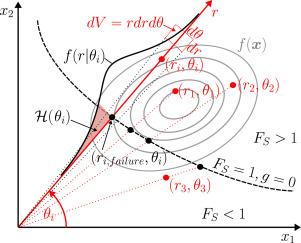超球积分可靠性法用于岩土极限状态的高效可靠性分析
IF 5.3
1区 工程技术
Q1 COMPUTER SCIENCE, INTERDISCIPLINARY APPLICATIONS
引用次数: 0
摘要
本文介绍了用于岩土极限状态高效可靠性分析的超球面积分可靠性方法(HINT)。该方法受剪切强度降低法(SSRM)机制的启发,SSRM 通常用于计算岩土极限状态的安全系数。HINT 利用了这一观察结果,即由 SSRM 计算出的安全系数不仅是对安全系数的点估计,而且还是在剪切强度参数空间中沿径向方向到破坏极限的距离度量。我们利用这一观察结果对超球面坐标系中的可靠性积分进行了转换,并开发出一种有效的岩土极限状态失效概率估算器。HINT 在几个基准问题上进行了检验,在中低维度可靠性问题上表现出稳定和高效的性能。如果像 SSRM 那样采用径向搜索机制,HINT 还可应用于一般可靠性问题。鉴于大多数商业岩土工程软件包中都有 SSRM,因此 HINT 完全适合用于推进岩土工程可靠性分析,并使其适用于更广泛的使用情况。本文章由计算机程序翻译,如有差异,请以英文原文为准。

Hyperspheric Integral Reliability Method for efficient reliability analysis of geotechnical ultimate limit states
This paper introduces the Hyperspheric Integral Reliability Method (HINT) for efficient reliability analysis of geotechnical ultimate limit states. The method is motivated by the mechanism of the Shear Strength Reduction Method (SSRM), which is often employed to calculate the factor of safety for geotechnical ultimate limit states. HINT exploits the observation that a factor of safety, computed by the SSRM, is not only a pointwise estimate of safety, but also a measure of distance to the failure limit along a radial direction in the space of the shear strength parameters. This observation is utilized to transform the reliability integral in the hyperspheric coordinate system and develop an efficient estimator of failure probability for geotechnical ultimate limit states. HINT was examined on several benchmarking problems, demonstrating stable and highly efficient performance on low to medium dimensional reliability problems. HINT can be also applied to general reliability problems if a radial search mechanism is implemented as in the SSRM. Given that the SSRM is already available in most commercial geotechnical software packages, HINT is perfectly suited to advance geotechnical reliability analyses and make them accessible to a wider set of use-cases.
求助全文
通过发布文献求助,成功后即可免费获取论文全文。
去求助
来源期刊

Computers and Geotechnics
地学-地球科学综合
CiteScore
9.10
自引率
15.10%
发文量
438
审稿时长
45 days
期刊介绍:
The use of computers is firmly established in geotechnical engineering and continues to grow rapidly in both engineering practice and academe. The development of advanced numerical techniques and constitutive modeling, in conjunction with rapid developments in computer hardware, enables problems to be tackled that were unthinkable even a few years ago. Computers and Geotechnics provides an up-to-date reference for engineers and researchers engaged in computer aided analysis and research in geotechnical engineering. The journal is intended for an expeditious dissemination of advanced computer applications across a broad range of geotechnical topics. Contributions on advances in numerical algorithms, computer implementation of new constitutive models and probabilistic methods are especially encouraged.
 求助内容:
求助内容: 应助结果提醒方式:
应助结果提醒方式:


